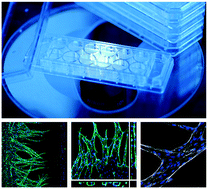Microfluidics within a well: an injection-molded plastic array 3D culture platform†
Abstract
Polydimethylsiloxane (PDMS) has been widely used in fabricating microfluidic devices for prototyping and proof-of-concept experiments. Due to several material limitations, PDMS has not been widely adopted for commercial applications that require large-scale production. This paper describes a novel injection-molded plastic array 3D culture (IMPACT) platform that incorporates a microfluidic design to integrate patterned 3D cell cultures within a single 96-well (diameter = 9 mm) plate. Cell containing gels can be sequentially patterned by capillary-guided flow along the corner and narrow gaps designed within the 96-well form factor. Compared to PDMS-based hydrophobic burst valve designs, this work utilizes hydrophilic liquid guides to obtain rapid and reproducible patterned gels for co-cultures. When a liquid droplet (i.e. cell containing fibrin or collagen gel) is placed on a corner, spontaneous patterning is achieved within 1 second. Optimal dimensionless parameters required for successful capillary loading have been determined. To demonstrate the utility of the platform for 3D co-culture, angiogenesis experiments were performed by patterning HUVEC (human umbilical endothelial cells) and LF (lung fibroblasts) embedded in 3D fibrin gels. The angiogenic sprouts (with open lumen tip cells expressing junctional proteins) are comparable to those observed in PDMS based devices. The IMPACT device has the potential to provide a robust high-throughput experimental platform for vascularized microphysiological systems.

- This article is part of the themed collection: RSC papers by NanoEngineering for Medicine and Biology 2018 Speakers


 Please wait while we load your content...
Please wait while we load your content...